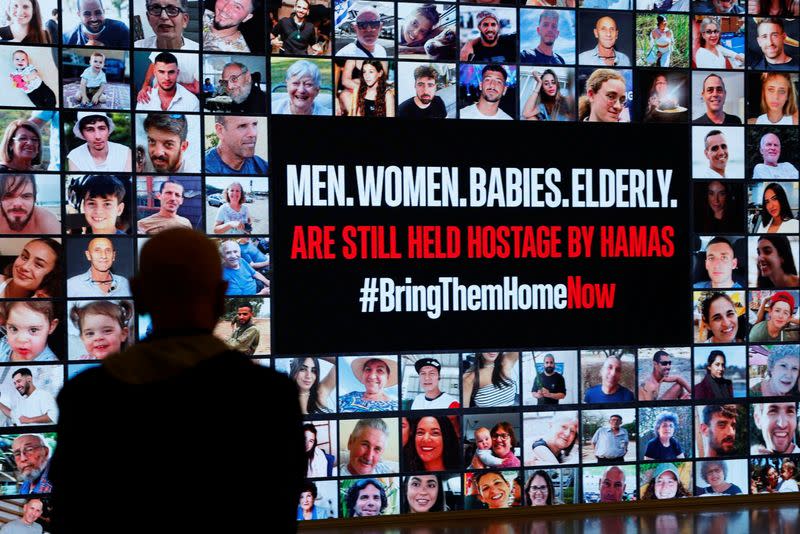Explainer-What do we know about Israeli hostages in Gaza?
(Reuters) -Hamas fighters released a first wave of 13 Israeli women and children on Friday under a truce deal and also released 11 farm workers from Thailand and the Philippines, after guns fell silent across the Gaza Strip for the first time in seven weeks.
Here is what we know about the hostages.
WHO ARE THE HOSTAGES?
Gunmen from Palestinian group Hamas took about 240 hostages and killed 1,200 people when they raided Israel on Oct. 7, according to the Israeli government. The hostages were from communities, including collective farms, called kibbutzim and military bases in southern Israel as well as people attending an outdoor music festival.
In addition to Israeli citizens, more than half the hostages held foreign and dual citizenship from some 40 countries including the U.S., Thailand, Britain, France, Argentina, Germany, Chile, Spain and Portugal, Israel's government has said.
According to Israeli media and the Israeli government, up to 40 hostages were children, including a 10-month-old baby and pre-schoolers.
Also among those taken were soldiers, elderly people and people with disabilities.
WHAT HAS HAPPENED TO THE HOSTAGES?
Hamas has to date released 28 hostages under the terms of a temporary truce deal. On Friday, 24 hostages were handed over at the Rafah border crossing - 13 Israelis, plus 10 Thais and a Filipino. The Israeli hostages included four children and their mothers, and five elderly women.
Before the deal was struck, Hamas had released four captives: U.S. citizens Judith Raanan, 59, and her daughter, Natalie Raanan, 17, on Oct. 20, citing "humanitarian reasons," and Israeli women Nurit Cooper, 79, and Yocheved Lifshitz, 85, on Oct. 23.
Israeli forces freed one hostage, Ori Megidish, a soldier, in their ground invasion of Gaza on Oct. 30.
The Israeli military said earlier this month that it recovered the bodies of two hostages in Gaza City, including 19-year-old soldier Noa Marciano.
The armed wing of the Palestinian militant group Islamic Jihad, which participated in the Oct. 7 raid with Hamas, announced late on Tuesday the death of another Israeli hostage but did not identify the individual.
WHERE ARE THE HOSTAGES BEING HELD?
Hamas has said it has hidden the captives in "safe places and tunnels" in Gaza. Israel says the group has a vast underground network where it stores weapons, commands operations and uses tunnels to move its fighters.
Lifshitz, an 85-year-old grandmother who was freed by Hamas, said that after she was seized, she was taken into underground tunnels that she compared to a spider web.
The Israeli military has said it found evidence that some hostages were held at or under hospitals.
The Israel Defence Forces said on Sunday that Marciano, the soldier whose body was recovered, was killed by Hamas within Al Shifa hospital. The military released video that it said also showed militants forcing two hostages into Shifa hospital on Oct. 7.
WHAT HAVE CONDITIONS BEEN LIKE FOR HOSTAGES?
Lifshitz said her captors separated hostages into small groups. She said she and a few others with her slept on mattresses on the floor of the tunnels. Doctors provided care and Hamas ensured conditions were hygienic, she said.
In a video released by Hamas in October, a 21-year-old French hostage was shown having her injured arm treated by a medical worker.
Hamas released another video in October that showed three women hostages denouncing Israeli Prime Minister Benjamin Netanyahu. He said they were used for "cruel propaganda".
HOW HAVE ISRAELIS REACTED TO THE HOSTAGE TAKING?
Family members and thousands of supporters have pressured the Israeli government to prioritise freeing the hostages, fearing they could be killed in Israel's retaliatory assault on Gaza. They have also travelled the world to highlight the hostage's plight.
After the first wave of hostages were released, Netanyahu repeated his commitment to bringing all of them home.
For the families of those who returned on Friday there was happiness mingled with concern for those who remained in Gaza.
(Reporting by Reuters bureauxWriting by Cynthia Osterman, Alexandra HudsonEditing by Deepa Babington and Mark Potter)




